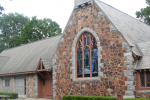September 2019
Mobilizing our Assets for Mission
Putting Our Buildings to Work
In the last half of the nineteenth century, renewed interest in religion and the social gospel sparked a movement. Gatherings that began in homes to worship and pray led to the formation of new Episcopal congregations. With the support of their bishops, land was purchased and churches were built. Those buildings became focal points for their cities and communities.
That’s our history. These buildings are an asset. We record them on our balance sheet. We insure them against peril and natural disasters. We know they have value. But how do we use our buildings in this modern society? How can we use them the other six days of the week? Finally, how can we monetize our assets?
Creative ideas for using our land and buildings
Speaking with churches across the country, we hear many creative ideas on how we can use our buildings and receive a financial benefit from them. Here a few ideas:
- Community garden: this works in urban, rural and suburban areas
- Parking lot rental: imagine your church on football or soccer Saturdays
- Commercial kitchens: partner with a local small business incubator to lease out your kitchens to entrepreneurs needing space to start their businesses
- Coffee shop: located in a downtown or college community, it can provide a welcoming and inviting space to meet and engage with the community
- 5k and half marathon refreshment area: offer your church or parking lot as a stop on the race course
- Private daycare: contract with a daycare program and lease classroom space
- Not for profit office space: lease classroom and office space at reasonable rates to organizations that can benefit from well-maintained facilities
- Convocation: partner with local schools (public and private) to hold events at your church
- Election day: churches offer a perfect polling location in some communities
- Concerts on the green: serves as an opportunity to showcase talents young and old
Congregations and communities both benefit when our buildings provide needed services
There are also wonderful stories of churches serving the community. One church in rural Ohio transforms itself weekly so the medical community can come in and volunteer its time to provide free medical and dental services.
Another church, with an after-school homework group for Hispanic students, now partners with local law enforcement to offer basic Spanish for first responders.
A third church, on the brink of closing with only nine members, was revitalized when a community daycare leased the lower level of their education building. The financial benefit from the arrangement brought a renewed sense of purpose to the congregation and the freedom to reach out to the community.
Working with the diocesan chancellor or parish attorney, agreements can be crafted to document the relationship with these partners and outline the financial benefit to the parish. Careful attention should be paid to potential tax issues, but those concerns can be reduced.
The benefits that can come from allowing our building assets to work for the parish are boundless. The untapped potential is amazing.
David Robinson has been the chief financial officer of the Diocese of Southern Ohio for ten years, handling the financial and accounting aspects of the diocese’s diverse operations and endowments. Additionally, he works with the 74 diocesan congregations, supporting and advising them on their buildings and other facilities. Growing out of his work in the diocese, David sits of the boards of St. Augustine University (Raleigh, North Carolina) and the Church Investment Group (NYC). He has also served on the board of directors of the CinFed Credit Union for the last 24 years.
Resources:
- Church Building Use by Annette Buchanan, ECF Vital Practices blog, May 31, 2017
- A Tale of Three Buildings by Janet Lombardo, ECF Vital Practices blog, February 18, 2019
- Sharing the Bounty of God’s Garden by Bill Eakins, Vestry Papers, November 2018
- Homegrown Communion: Faith, Land and Neighbor an ECF webinar presented by Sarah Nolan, September 26, 2013






